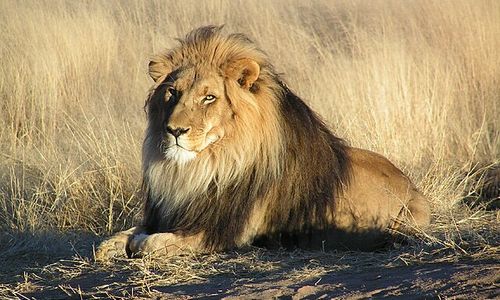Answers For Lecture about lions
Answers and detail explain for Lecture about lions
Explain
Lecture about lions

Narrator: You will hear a lecture on lions,
Lecturer: As part of this series of lectures on wildlife, I'm going to talk today about lions, about their history and about some of the work that's been done with lions in recent years.
1When we think of lions, we tend to think of Africa, as this is the only area of the world where they still exist in the wild, apart from some small groups in the Indian forest of Gir. But you might be surprised to know that lions were once virtually everywhere on the planet. In fact, if you go back 500.000 years ago, there were more lions roaming the world than dogs or monkeys. You could bump into one in London, Moscow or LA, in every part of Africa, apart from the desert; in fact, 2the only continents that were and have always been lion-free were the frozen plains of Antarctica - which were obviously much too inhospitable for this jungle creature - and Australia, though there is plenty of bushland there.
So what happened? Well, we know for certain that as recently as the 1800s - that's just 200 years ago - lions were being hunted to extinction in some parts of the world, sometimes just for sport. But long before that, about 10.000 years ago, lions started to disappear from various corners of the globe.3 Scientists believe there was the usual battle with our human ancestors for food, in the form of other, smaller creatures, with many lions also being killed to make clothing.
So lions may have gone from Europe, but there are plenty of prehistoric paintings to witness their presence. And they reveal some interesting facts.
Let's take a look … These cave paintings were found in France - the outlines are slightly blurred because they were hand-drawn using materials like charcoal or ochre. But the images are still very dear and the interesting thing is that, as you can see, in the past, 4lions were actually a lot bigger than they are now - they come up to this man's waist! You may think the size has been exaggerated because of the man's fear, but there's plenty of fossil evidence that supports the larger proportions these animals once had, when you compare them with the African lions of the present day. The other curious thing here is that none of the male lions seen in cave paintings like this have the long, black or blond hair around their necks and faces that is called a mane.5 Now, the lion's mane is another interesting feature of these creatures. No one seems to know much about it - there are none in cave paintings like these - and, even today, the date when the lion's mane first appeared is unknown. and there is disagreement among scientists as to what its purpose is.
A lot of work has gone into researching this. If you think about it, no other cat has a mane. 6So why does a lion have one? And a lion's mane can be various lengths and colours, not unlike human hair: some are long, some are short: they can be black, brown or blond and they can be in good or bad condition. 7What scientists do know is that when lions fight, they tend to go for each other's necks and, at first, this led some researchers to believe that the mane acts as a form of protection during battles with neighbouring prides. That may be partly true. But not everyone agrees it's the whole explanation. One leading lion expert believes that manes are more to do with attracting females and scaring off males, and he's run an experiment to test this theory out.
8What he did was to make five toy lions and put them in the lions' territory. He made sure they all looked different - some had long. light-coloured manes, some had shore dark ones and so on. He put these in places where they were sure to be seen, and for a while the lions ignored them. But eventually they went up to the models. And, well.9 The female lions were attracted to the ones that had long, dark manes. The male lions weren't, they just kept away from them - what interested them were the ones with shorts, blond manes. They approached these and bit or clawed them quite aggressively.
When the results of this study were compared with the real-world situation, it was found that lions with long, dark manes tend to be the healthiest, while ones with short. blond manes are more likely to be injured or sick. 10Thus, the team concluded that a lion's mane is effectively a status symbol; that it shows how strong and healthy the lion is and, as a result, makes the lion more attractive to females.
Complete the notes below. Write NO MORE THAN TWO WORDS for each answer.
LIONS
Lion history
- Found today in Africa and a 1 (forest) in India
- Have lived on every continent apart from Antarctica and 2 (Australia)
- Killed by early humans:
- in competition for food
- for 3 (clothing)
Cave paintings
- 4 (Fossil evidence) confirms European lions much bigger than African lions
- Date of first appearance of mane 5 (is unknown | unknown)
Purpose of mane
- Mane is comparable to 6 (human hair) in some ways
- Researchers first believed mane used for 7 (protection) during fights.
The lion expert's study
- Made some 8 (toys | toy lions | models | model lions) with different manes
- 9 (long dark | dark long) manes attracted female lions
- Conclusion: mane is a 10 (status symbol)
![[Forecast Q2-2025] - Biology lecture](https://static.helik.app/reading/8fd3d7d2-ccf9-47a3-8920-2e7a3b0d6607)
![[Forecast Q2-2025] - Living in the City](https://static.helik.app/reading/1a60bcf3-f3a7-4e9b-97a2-94d156a0de3b)
![[Forecast Q2-2025] - Student Union](https://static.helik.app/reading/fb443123-8c1d-447e-8c79-5a01650f4754)
![[Forecast Q2-2025] - Fruit-picking Job in an Orchard](https://static.helik.app/reading/e1968346-6c55-44ae-b8d3-f6a4fb7207b9)
![[Forecast Q2-2025] - University Crime Prevention](https://static.helik.app/reading/bdda593e-16d6-4c72-8a12-b116e917b27c)
![[Forecast Q2-2025] - Business Course](https://static.helik.app/reading/3308e282-99a6-4bcb-9d22-0b488701d968)
![[C20T1] - Choosing a restaurant](https://static.helik.app/reading/e9b21123-c43c-42fb-88b7-5d0be3a37e03)
